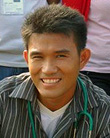Advances in healthcare delivery such as telemedicine1-3, as well as advances in medical education4,5, have helped improve the problem of healthcare delivery in rural communities. Many of these strategies, however, rely on technology that is not always available. Providing health care in the most remote parts of the world remains challenging. Often, the only way for many patients to get health care is from mobile clinics6. The focus of this article is to demonstrate an innovative mobile clinic model that was developed in 2008 to serve a remote population on the Tonle Sap Lake in Cambodia.
One country that presents unique challenges for rural and remote medicine is Cambodia, with 80% of the population living in rural areas7. The adult mortality rate in Cambodia is double that of the regional (WHO Western Pacific Region) average, and the under-5 years mortality rate is more than 2.5 times the regional average7. Extreme poverty has been detrimental to the health of many Cambodians with 22.8% living with less than US$1 per day8. As expected, the problems are worse in rural areas where many people do not have access to health care9. In Cambodia, 95% of births in urban areas are attended by a skilled health worker, whereas only 67% are attended in the rural areas7. The under-5 years mortality rate in urban areas is 29 per 1000 live births, compared to 75 per 1000 live births in rural areas7. Moderate or severe malnutrition affects 42.2% of children under 5 years in rural areas compared to 27.5% of children in urban areas10. A recent study of health-seeking and access to care in Cambodia found that poverty and lack of resources were significant determinants in healthcare decisions made by mothers for their children11. Health problems also exist for older adults. Zimmer demonstrated that older adults in rural Cambodian regions who have the least amount of wealth have more health problems than those older adults with more wealth12.
One of the most isolated areas in Cambodia is the Tonle Sap Lake region. The Tonle Sap Lake is the largest freshwater lake in South-East Asia and covers an area of 2500-3000 km213. Five provinces surround that lake, with a combined estimated population of 1.25 million14. A fraction of these people live directly on the lake, in floating villages (Fig1). The people who live on the lake are the poorest and rely on fishing as their main source of income and food while others who live further away have varied economic livelihoods13. They are completely isolated from the rest of the country and most often have to travel a full day by boat to any health clinic or hospital. For the vast majority, this is an impossible journey as the cost is equal to several months of income for them. Living in such a remote region, the people in the floating villages have very limited access to any type of health care.
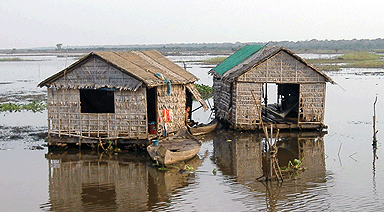
Figure 1: Typical houses within a floating village on Tonle Sap Lake, Cambodia.
Intervention
The Lake Clinic - Cambodia
The Lake Clinic - Cambodia (TLC) was established as a non-government organization in 2007. By February 2008, construction had begun on the TLC-1, nicknamed 'the charming duckling', and was completed in July 2008 (Fig2). It can sleep five people, has a small kitchen, toilet, and plenty of extra space for additional passengers and equipment. It was designed with a special flat bottom and shallow draft to allow it to adapt to the various seasons. During the rainy season, when the water level is high, the TLC can travel over flooded forests. A 200 horsepower motor can carry the boat at 11 km/h, and the 300 L fuel tank allows the boat to travel safely for 15 hours.
The TLC is staffed by a local physician, one nurse, one midwife, a cook/captain, and at least one or two volunteers to assist with registration and logistics, and one or two volunteer physicians or dentists. The physicians and nurses have basic equipment such as thermometers, stethoscopes, otoscopes, ophthalmoscopes, O2 saturation probes, and urine dipsticks. There is a wide range of medication from antibiotics, to multivitamins and chronic hypertension medications. The medications are re-stocked each week.
TLC is funded by several major international sources. IMPACT Foundation UK and IMPACT Norway are TLC's largest sponsors and fundraisers. They have been joined by IMPACT Switzerland. In the USA, Friends Without A Border is a major donor. In Germany, Angkors-Kinder is the major sponsor. In addition to large foundations, many private individuals have given generously to TLC directly, and through the TLC Facebook site.
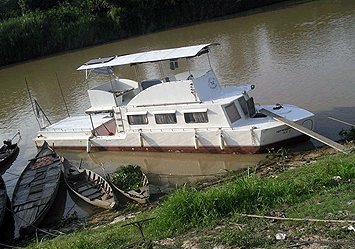
Figure 2: TLC-1, the boat used to provide health care to people
from the remote fishing villages on Tonle Sap Lake, Cambodia.
Initial survey and planning
In August 2008, TLC surveyed the people of seven floating villages on the Tonle Sap Lake to determine how best to use its resources. The seven villages were Moat Klas and Steung Chrove in the Siem Reap Province, and Pech Chakrey, Poveuy, Don Sdeung, Peam Bang, and Balot in the Kompong Thom Province (Fig3). These villages were 35-65 km from the nearest government health facility. The villages themselves migrate along the rivers and tributaries of the lake, sometimes as often as five times per year, for protection from storms and waves during the monsoon season.
Expansion
After completion of the initial survey, the decision was made to focus on the villages of Moat Klas, Steung Chrove, and Pech Chakrey. The TLC visited each of these villages weekly and provided primary health care, dental care, pre-natal care, and immunizations. TLC became fully operational at the end of October 2008. In 2009, TLC expanded to serve four additional villages: Balot, Don Sdeung, Peam Bang, and Poveuy. In addition, a village health volunteer (VHV) system was established. The VHVs work in each of the villages and are responsible for monitoring the health of 30-50 families each. They are provided basic training in cardiopulmonary resuscitation, first aid, family planning, immunization education, nutrition and household hygiene. In late 2011, seeing an increasing need for healthcare in the remote fishing villages, TLC further expanded into two teams. The teams operate simultaneously during the week, with one team (the Lake Team) launching from Kampong Khleang, serving villages on the lake, and the other team (the River Team) launching from the other side of the lake at Chhnok Throu, serving villages along the Steung Sen River. Floating clinics equipped with solar power, bathrooms, and private examining rooms were also built and are now located at three sites: Peam Bang, Moat Klas and Okarlev. Over the past 5 years TLC has grown to serve 19 different villages (Fig3). In each of the villages that TLC operates in, a close connection and open dialog is kept with the Chief of the village. It is through the Chief that clinics are organized and any new interventions are discussed to see if they would be appropriate for that particular population.
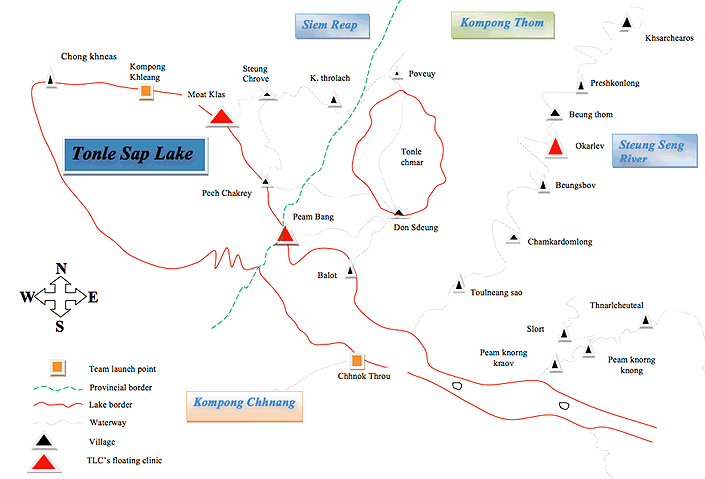
Figure 3: Map of Tonle Sap Lake, Cambodia, showing the 19 villages served, including three villages that have floating clinics (red triangles).
Services provided
The most important goal of TLC is to provide good primary care with a focus on preventative medicine and healthcare education. Every patient has a thorough history taken and receives a physical exam. Given the limited resources for each trip, most diagnoses are clinical. However, some diagnoses can be made with the assistance of simple tools such as a urine dipstick for a urinary tract infection, blood pressure cuff for hypertension, and a glucometer for diabetes. Records of each patient encounter are kept with the patient's medical chart, and these are organized by village. Using this system makes follow-up easier, and it has been vital in making the decision to refer a patient if their condition is not improving or is getting worse over time.
Although the majority of patient encounters are pediatric and adult visits for specific symptoms, the practitioners that work with TLC spend additional time with each patient reviewing preventative interventions and educating patients. For example, pediatric patients, no matter what their presenting complaint, routinely receive vitamin A supplementation and antihelminthic (deworming) treatment. Adult patients have their blood sugar and blood pressure routinely monitored and are treated and followed closely for diabetes and hypertension. With a nurse and midwife as full-time providers, TLC is also able to do antenatal visits, family planning visits and give important health education on topics such as obtaining clean water and basic hygiene. When available, dental services and eyecare services are available with specialists who take care of disease and do preventative treatments. In cooperation with the Cambodian Ministry of Health, TLC also offers vaccinations for pediatric patients. All of the services offered by TLC are free of charge to the healthcare users. Even when patients need to be transported to Siem Reap for a higher level of care, their transportation and accommodation costs are covered by TLC.
Data collection
Since its inception, TLC has had two staff members in charge of keeping records for all patients that are seen in the mobile clinics. Each patient has a paper chart, which is used each time they come for care. The charts are organized by village and are brought aboard the TLC each week. At the end of the week, one member of the team reviews each chart of all the patients seen and enters this information into a computer database. Over time, this data has been analyzed in more detail, and the results obtained (29 October 2008 to 31 December 2012) are given in the following section. Patient age is classified as either pediatric (0-14 years) or adult (≥15 years). Beginning in 2009, the adult population was also classified as male or female, and diagnoses for each patient were recorded.
Results
In total, 13 160 pediatric visits and 17 722 adults visits were made. The breakdown into individual years is given in Figure 4. In addition to these services, 739 patients received dental care, 346 patients received eye care, there were 1239 antenatal visits, 116 family planning visits, and 1600 patients received health education. In total, 130 patients were referred to hospitals or health centers for a higher level of care. A total of 6627 immunizations were provided with the assistance of the Cambodian Ministry of Health (Fig5).
Of all 12 844 pediatric visits since the beginning of 2009, the majority were diagnosed with an upper respiratory infections. This was followed by parasitism, gastroenteritis, skin infection, and viral syndrome. Malnutrition was diagnosed in only 68 (0.5%) of patients (Table 1).
Of the 17 274 adults visiting since 2009, the majority were diagnosed with gastritis. This was followed by upper respiratory infection, myalgia, hypertension, and skin infection (Table 2).
TLC's total annual expenditures from 2008 to 2012 were $112,831, $226,586, $165,386, $229,136, and $404,035, respectively. A large portion of the expenditures for 2012 was used to build the floating clinics.
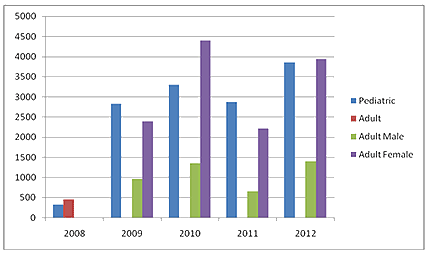
Figure 4: Number of patients seen each year by The Lake Clinic - Cambodia.
(Female and male data not available for 2008. Adult patients are
defined as aged ≥15 years, and pediatric patients aged <15 years.)
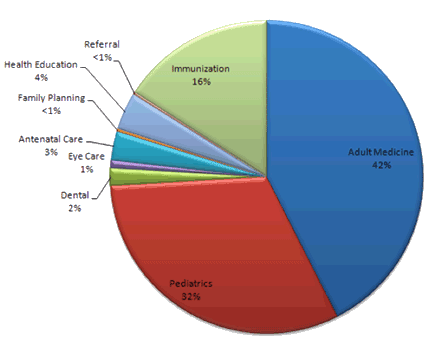
Figure 5: Services provided by The Lake Clinic - Cambodia. (Adult patients
are defined as aged ≥15 years, and pediatric patients aged <15 years.)
Table 1: Five most prevalent pediatric (age <15 years) diseases seen
in 12 844 encounters of The Lake Clinic - Cambodia, 2009-2012
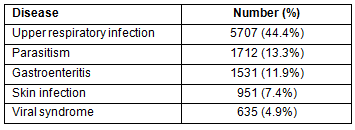
Table 2: Five most prevalent adult (age ≥15 years) diseases seen
in 17 274 encounters of The Lake Clinic - Cambodia, 2009-2012

Providing care to rural citizens is a difficult task, to say the least, in Cambodia. In the 1970s, the regime of Pol Pot destroyed the professional class and only 25 doctors remained at the Cambodian Ministry of Health15. A public and private healthcare system emerged in the years that followed, but the system has not yet reached some of the most important Millennium Development Goals (MDG). Specifically, MDG 4, reduction of under-five childhood mortality by two-thirds, and MDG 5, reduction of maternal mortality by three-quarters, have not been reached8. Major healthcare reforms have not been adequate to meet the needs of the population, especially in rural areas, in part due to shortages in healthcare providers16. To provide healthcare to the poorest, rural citizens, there needs to be not only strategies to keep health workers in rural areas16, but also innovative methods of healthcare delivery. The Lake Clinic has been able to achieve a significant goal: to provide primary care medical services to a remote area of Cambodia, where no medical services were previously available.
Diseases
Looking at the data more specifically can give some insight into future directions for TLC. In the pediatric population, three of the five most common diagnoses were upper respiratory infection, gastroenteritis, and viral syndrome. This is not surprising as these are very commonly diagnosed pediatric diseases, even among developed Asian countries17. What is interesting is the very low number of children seen with malnutrition, accounting for only 0.5% of the total number of visits. Although this only accounts for patients brought for treatment, and does not represent the true prevalence, it is far lower than what would be expected in the rest of the country10. This may be due to the fact that the Tonle Sap Lake is abundant with food for the people who live on the lake. However, the authors have observed that although the people are able to eat seafood, their intake of fruits and vegetables is extremely limited. Fruits and vegetables need to be brought in from distant locations and they are either too expensive for most people to purchase, or largely spoiled when they arrive. This may be the reason for so many diagnosed skin infections in children and adults. Zinc, for example, is known to be involved in the maintenance of skin and mucous membranes18, and micronutrient deficiencies could be associated with the infections seen in this population.
In the adult population, it is interesting to note that the most diagnosed condition among all visits was gastritis. The cause is unknown; however, it could be due to Helicobacter pylori infection because infection with this organism is much higher in developing countries compared to developed countries19. Other possibilities include alcohol intake or traditional medicines. Further study is needed to confirm this.
Environment
The biggest challenge for TLC and the inhabitants of the Tonle Sap Lake is the environment. Not only is access to these patients difficult, because they live in remote areas on the lake, but the routes to these villages are dependent on the water level, which is highly variable. As can be seen from the results of this study, although TLC continues to expand each year and has the capacity to see more and more patients, there was a drop in the number of patients seen in 2011. This was due to very low water levels preventing access to many of the villages regularly served by TLC. Unfortunately, this is largely uncontrollable because lake levels depend on weather, socioeconomic factors, and the development of hydroelectric dams along the Mekong River20.
Future directions
To address the main challenge of getting to all patients, especially in the dry season, a new boat, the TLC-4, was built and construction was completed in December 2013 (Fig6). It is now fully operational. This boat is lighter, and has a propeller much closer to the water level, allowing it to travel in a depth of only 1 m of water. In addition to addressing the environmental challenge, TLC will be taking an enormous step forward in terms of their diagnostic capability. TLC has recently partnered with the Angkor Hospital for Children in Siem Reap and now has access to their laboratory. This will greatly assist the staff of the TLC who now can only rely on clinical diagnoses. With the ability to do stool studies and blood tests, many of the patients will be able to receive a more precise diagnosis. For example, in the pediatric population physicians can currently diagnose parasitism based on history and physical exam, but with the capability to do stool studies, the team will be able to see exactly which parasites are causing the infection. This is something that has only been studied in this area by one group previously21. Stool studies may also assist with the causes of gastroenteritis, which many children suffer from.
In the adult population, TLC may be able to diagnose the exact cause of gastritis, which so many patients have. In addition to laboratory capabilities, the new partnership with the Angkor Hospital for Children will allow physicians and nurses from TLC to participate in weekly continuing medical education. As TLC continues to expand, the VHV system is continuing to expand, with more volunteers and more training. Other VHVs in Cambodia have been shown to fill the gaps in disease surveillance22, and in Thailand, VHVs have been taught more specialized skills23. The goal of TLC is to further train VHVs with skills such as monitoring blood sugar, monitoring blood pressure, and basic neonatal resuscitation through the Helping Babies Breathe program.
By upgrading the skills of the VHVs, and educating patients to make better healthcare decisions, TLC has made a sustainable impact. However, as a non-profit organization, TLC still relies on international donors to support its daily operations. The only way for TLC to be truly sustainable will be to have the government take a more active role in providing health care to these villagers as the Cambodian healthcare system evolves.
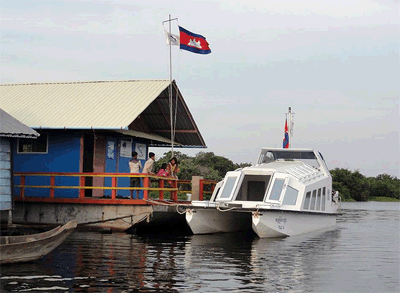
Figure 6: The recently completed TLC-4.
Conclusion
In a region where thousands of patients have absolutely no contact with any healthcare providers other than traditional healers, TLC provides vital medical services. With a focus on prevention and education, TLC continues to see an increasing number of patients each year despite the environmental challenges in this remote area of the world. The continued expansion in terms of boat capabilities, the VHV network, and laboratory capabilities, will continue to serve these patients in the future.
Acknowledgements
The authors would like to thank all of the staff at the Angkor Hospital for Children for providing the highest quality inpatient care for all the children that were referred there. The authors are also grateful to all the donors of TLC who have made the project a huge success. Travel support for Dr. Merali was provided by the Massachusetts General Hospital Center of Expertise in Global and Humanitarian Health, and the American Academy of Pediatrics.
References
1. Froehlich W, Seitaboth S, Chanpheaktra N, Pugatch D. Case report: an example of international telemedicine success. Journal of Telemedicine and Telecare 2009; 15(4): 208-210.
2. Heinzelmann PJ, Jacques G, Kvedar JC. Telemedicine by email in remote Cambodia. Journal of Telemedicine and Telecare 2005; 11(Suppl 2): S44-47.
3. Lugn NE. Global health care - bridging the gap. Journal of Telemedicine and Telecare 2006; 12(3): 109-110.
4. Couper I, Worley PS, Strasser R. Rural longitudinal integrated clerkships: lessons from two programs on different continents. Rural and Remote Health 11(1):1665 (Online) 2011. Available: www.rrh.org.au (Accessed 16 February 2013).
5. Strasser RP. Community engagement: a key to successful rural clinical education. Rural and Remote Health 10(3):1543 (Online) 2010. Available: www.rrh.org.au (Accessed 16 February 2013).
6. Morikawa MJ, Schneider S, Becker S, Lipovac S. Primary care in post-conflict rural northern Afghanistan. Public Health 2011; 125(1): 55-59.
7. World Health Organization. Health profile - Cambodia. (Online) 2012. Available: http://www.who.int/countries/khm/en (Accessed 16 February 2013).
8. United Nations Statistics Division. Millennium Development Goals indicators. (Online) 2012. Available: http://mdgs.un.org/unsd/mdg (Accessed 16 February 2013).
9. Hong R, Mishra V. Effect of wealth inequality on chronic under-nutrition in Cambodian children. Journal of Health, Population and Nutrition 24(1): 89-99. (Online) 2006. Available: http://www.jhpn.net/index.php/jhpn/article/view/751 (Accessed 20 February 2013).
10. Cambodia 2010: Results from the Demographic and Health Survey. Studies in Family Planning 2012; 43(1): 63-68.
11. Khun S, Manderson L. Health seeking and access to care for children with suspected dengue in Cambodia: an ethnographic study. BioMed Central Public Health 7: 262. (Online) 2007. Available: http://www.biomedcentral.com/1471-2458/7/262 (Accessed 5 March 2013).
12. Zimmer Z. Poverty, wealth inequality and health among older adults in rural Cambodia. Social Science and Medicine 2008; 66(1): 57-71.
13. Matsui S, Keskinen M, Sokhem P, Nakamura M. Tonle Sap: experience and lessons learned brief. International Waters: Science Database. (Online) 2006. Available: http://projects.csg.uwaterloo.ca/inweh (Accessed 5 March 2013).
14. Navy H, Leang S, Chuenpagdee R. Socioeconomics and livelihood values of Tonle Sap Lake fisheries. Phnom Penh: Inland Fisheries Research and Development Institute, 2006.
15. Heng MB, Key PJ. Cambodian health in transition. British Medical Journal 1995; 311(7002): 435-437.
16. Chhea C, Warren N, Manderson L. Health worker effectiveness and retention in rural Cambodia. Rural and Remote Health 10(3): 1391 (Online) 2010. Available: www.rrh.org.au (Accessed 10 March 2013).
17. Liao P, Ku M, Lue K, Sun H. Respiratory tract infection is the major cause of the ambulatory visits in children. Italian Journal of Pediatrics 37: 43 (Online) 2011. Available: http://www.ijponline.net/content/37/1/43 (Accessed 12 March 2013).
18. Roth DE, Caulfield LE, Ezzati M, Black RE. Acute lower respiratory infections in childhood: opportunities for reducing the global burden through nutritional interventions. Bulletin of the World Health Organization 2008; 86(5): 356-364.
19. Hunt RH, Xiao SD, Megraud F, Leon-Barua R, Bazzoli F, van der Merwe S, et al. Helicobacter pylori in developing countries. World Gastroenterology Organisation Global Guideline. Journal of Gastrointestinal and Liver Disease 2011; 20(3): 299-304.
20. Keskinen M, Salmivaara A, Paradis S, Lauri H, de Moel H, Ward P, et al. Exploring Tonle Sap futures: baseline results from hydrological and livelihood analyses. Mekong Program on Water Environment and Resilience. (Online) 2011. Available: http://www.mpowernetwork.org/Knowledge_Bank/Key_Reports/index.html (Accessed 12 March 2013).
21. Sohn WM, Chai JY, Yong TS, Eom KS, Yoon CH, Sinuon M, et al. Echinostoma revolutum infection in children, Pursat Province, Cambodia. Emerging Infectious Disease 2011; 17(1): 117-119.
22. Oum S, Chandramohan D, Cairncross S. Community-based surveillance: a pilot study from rural Cambodia. Tropical Medicine and International Health 2005; 10(7): 689-697.
23. Nualnetr N, Sakhornkhan A. Improving accessibility to medical services for persons with disability in Thailand. Disability, CBR, and Inclusive Development 2012; 23(12): 34-49.


